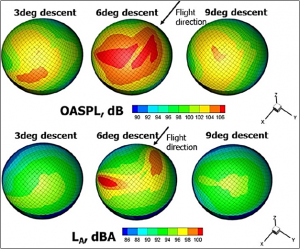In response to a request for information related to ongoing electric vertical takeoff and landing (eVTOL) systems for noise reduction of rotary-wing aircraft, Defense Systems Information Analysis Center (DSIAC) staff reviewed rotary-wing noise-reduction efforts associated with the Vertical Flight Society (VFS), formerly the American Helicopter Society, Inc. A synopsis of the VFS program and other information was compiled for distribution. DSIAC found that noise- reduction and electric vertical takeoff and landing systems information could be useful for rotary-wing acoustic signature reduction during ingress and egress, logistics resupply, personnel extraction, and other operations.
The author of this response, Scott Armistead, was familiar with efforts by the Services to reduce rotary-wing aircraft acoustic (noise) signature and ongoing efforts by the Vertical Flight Society (VFS) that could be leveraged to support military operations. He provided a synopsis of the VFS program as well as additional information related to the inquirer’s request.
Mr. Armistead is currently the Senior Staff Engineer for the Defense Systems Information Analysis Center (DSIAC) and has over 30 years of experience as a systems engineer supporting research, development, testing, and evaluation of military weapon systems, ground vehicles, and aircraft. His experience includes signature data collection; analysis; and modeling and simulation for blue, gray, and red aircraft, vehicles, weapons, personnel, clutter, and backgrounds and the use of this information to develop and test acoustic, seismic, magnetic, electro-optical (infrared, visible and ultraviolet), and electromagnetic (millimeter wave) band signature-reduction technologies, materiel solutions, and associated tactics and procedures for employment.
VFS, formerly known as the American Helicopter Society (AHS), Inc., has 21 active technical committees composed of government, industry, and academia members from around the world. These technical committees support research and disseminate information through annual forums, technical conferences, workshops, short courses, Vertiflite magazine [1], and peer-reviewed articles in the Journal of the American Helicopter Society [2]. The Acoustics Committee has an ongoing helicopter noise-reduction initiative [3] that is related to a broader set of collaborative noise-reduction efforts supported by the National Aeronautics and Space Administration (NASA), Federal Aviation Administration (FAA), and Department of Transportation (DOT) John A. Volpe National Transportation Systems Center, in conjunction with academic institutions such as Penn State University (PSU).
Documents available through the VFS website have relevant information on eVTOL systems and technologies that may be of interest for potential application to relatively quiet ingress/egress, logistics resupply, personnel extraction, etc. The VFS eVTOL briefing [4], in particular, is a useful presentation.
There is a significant amount of information related to the study, measurement, modeling and simulation, and reduction of helicopter noise (acoustic signature reduction). For instance, the article, “U.S. Government Research Targets Helicopter Noise,” [5] explains how simply changing the descent angle of a Bell 430 helicopter from 6° to 3° or 9° drastically reduces noise. Blade-vortex interaction peaks at around 6° of descent, while a steeper or shallower descent angle reduces noise levels, as depicted in Figure 1 [5].

OASPL=Overall sound pressure level; LA= Loudness based on a standard A weighting curve correction.
Figure 1: Depiction of the Noise Hemisphere Generated by a Bell 430 Descending with No Acceleration (Source: Pennsylvania State University [5]).
The presentation, “Flying Quiet Webinar,” [6] highlights efforts by NASA, the Volpe National Transportation Systems Center, and PSU to develop a noise measurement and modeling process that is leveraged through their iFlyQuiet Strategy to train pilots to fly quieter for community noise reduction. Though the effort has its own specific goals, the group could possibly tailor specific efforts for modeling other rotary-wing aircraft, flight profiles, etc., to support development of tactics, techniques, and procedures that would significantly reduce noise.
VFS provides its members access to rotorcraft noise-related research documents through an online library, the Rotorcraft Noise Library [7], which includes annual forums and technical committees. The library also provides links to noise reduction-related publicly accessible documents. Additionally, their online Vertipedia [8] provides access to general and technical information on nearly 900 aircraft and 500 powerplants as well as information on significant vertical flight-related milestones, organizations, and people.
References
[1] The Vertical Flight Technical Society. Vertiflite Magazine. https://vtol.org/publications/ vertiflite-magazine, accessed February 2019.
[2] The Vertical Flight Technical Society. Journal of AHS. https://vtol.org/publications/journal-of-ahs, accessed February 2019.
[3] The Vertical Flight Technical Society. “Noise Initiative.” https://vtol.org/what-we-do/noise-initiative, 17 November 2017.
[4] Hirschberg, M. “What’s all the buzz about eVTOL?” The Vertical Flight Technical Society, https://vtol.org/files/ dmfile/eVTOL-Noise-forFAA-16Nov20171.pdf, April 2017.
[5] Nelms, D. “U.S. Government Research Targets Helicopter Noise.” Vertiflite, pp. 18–21, https://vtol.org/files/dmfile/ Noise-Research-Vertiflite-ND171.pdf, November/December 2017.
[6] Page, J. “Flying Quiet Webinar [PDF Slides].” Presented as part of the Helicopter Association International – American Helicopter Society sponsored webinar, The Vertical Flight Technical Society, https://vtol.org/files/dmfile/Volpe-FlyingQuiet-16Nov2017-Final1.pdf, 16 November 2017.
[7] The Vertical Flight Technical Society. “Rotorcraft Noise Library.” https://vtol.org/what-we-do/noise-initiative/noise-library, accessed December 2017.
[8] VFS. “Vertipedia.” https://vertipedia.vtol.org/, accessed December 2017.


